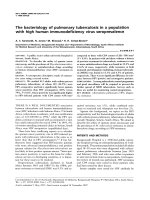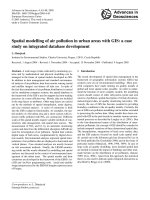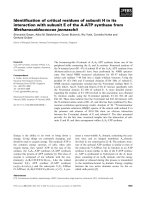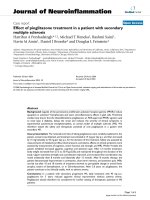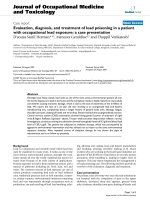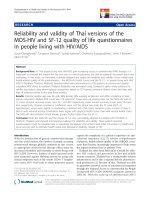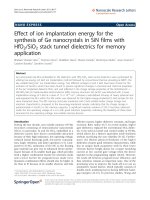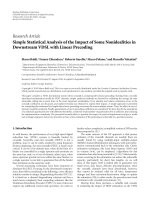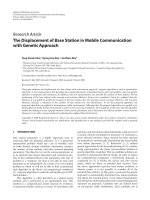ENANTIOSEPARATION OF CHIRAL DRUGS IN LIQUID CHROMATOGRAPHY WITH ANTIBIOTIC CAPPED MACROCYCLE BONDED SILICA PARTICLES AS CHIRAL STATIONARY PHASES
Bạn đang xem bản rút gọn của tài liệu. Xem và tải ngay bản đầy đủ của tài liệu tại đây (2.16 MB, 160 trang )
ENANTIOSEPARATION OF CHIRAL DRUGS IN
LIQUID CHROMATOGRAPHY WITH
ANTIBIOTIC-CAPPED MACROCYCLE-BONDED
SILICA PARTICLES AS CHIRAL STATIONARY
PHASES
ZHAO JIA
(M.Sc., NUS)
A THESIS SUBMITTED
FOR THE DEGREE OF DOCTOR OF PHILOSOPHY
DEPARTMENT OF OBSTETRICS AND
GYNAECOLOGY
NATIONAL UNIVERSITY OF SINGAPORE
2015
I
DECLARATION
I hereby declare that the thesis is my original work and it has been written by
me in its entirety. I have duly acknowledged all the sources of information
which have been used in the thesis.
This thesis has also not been submitted for any degree in any university
previously.
Zhao Jia
22 Jan 2015
I
II
ACKNOWLEDGEMENT
A quote from Jacob Riis always spurs me on to greater effort and may be the
best footnote to illuminate the time of my Ph.D. study: When nothing seems to
help, I go and look at a stonecutter hammering away at his rock perhaps a
hundred times without as much as a crack showing in it. Yet at the hundred
and first blow it will split in two, and I know it was not that blow that did it,
but all that had gone before.
A true Ph.D. means far more than the degree title. The core of Ph.D. career is
not to pursue nice experiment data for publication, but a journey to transcend
oneself, to perfect the philosophy of life, to own the wisdom of thinking.
Beyond the overwhelming experience of reading journals, staying up for
experiments, giving presentations and writing papers, it is truly a training
process to learn how to consider, analyze and solve problems in aspects of life.
Many years later, I may forget the great mass of details mentioned in this
dissertation. But I will do remember the bittersweet journey and the wonderful
time with you forever. Firstly, I am deeply grateful to my supervisor Dr. Gong
Yinhan. To be your student makes me lifelong benefits. I learnt a lot from you
about life, family and research. Your technical excellence and the ability to
deal with problems set a good example for me to follow. In addition, it is my
real pleasure to be oriented and supported with your care and patience through
my student career. Meanwhile, I have been very privileged to get to know and
III
to collaborate with the “bond of sisters in chromatography”— Dr. S.K.
Thamarai Chelvi, Dr. Wang Chong, Dr. Soh Shu Fang, Ms Tan Huey Min, Ms
Tan Daphane, Ms Tan Sharon, Ms Pang Shu Hui and Ms Shan Yu. I really
appreciate your sincere help in life and study, and the enjoyable discussions
with you about life, politics, culture, food, dialect, Ph.D. and all that make my
student life colourful, with no time for boredom. I also want to thank all other
colleagues who helped me during last four years in particular Prof. Yong Eu
Leong, Dr. Li Jun, Dr. Tong Yoke Yin, Dr. Hong Xin, Mr Zhang Zhiwei, Ms
Chua Seok Eng, Ms Mok Poh Pheng and Ms Tang Sing Kwang.
Last but not least, I wish to express my sincere appreciation to my parents,
grandparents and other family members for their unconditionally infinite
support and selfless giving throughout everything in my life. Special thank to
my wife for her kind-hearted support, understanding and encouragement from
our initial encounter.
IV
TABLE OF CONTENTS
Declaration page I
Acknowledgements II
Table of contents IV
Summary VIII
List of publications IX
List of tables XI
List of figures XIII
Abbreviation XVI
Chapter 1. Introduction
1.1 Chirality and enantiomers 2
1.2 Enantioseparation 7
1.3 Chromatography 9
1.4 Chiral chromatography 12
1.5 Chiral stationary phase 15
1.6 Research objectives and hypothesis 18
Chapter 2. Synthesis of novel macrocycle-bonded silica stationary phases
2.1 Introduction 21
2.1.1 Cyclodextrins and calixarenes 21
2.1.2 Vancomycin and rifamycin 24
2.1.3 Novel CSPs with multiple recognition sties 27
2.2 Experimental 28
2.2.1 Reagents and materials 28
2.2.2 Apparatus 30
V
2.2.3 Synthesis of modified ß-CD-bonded silica particles 31
2.2.4 Synthesis of modified MCR-bonded silica particles 40
2.3 Results and discussion 47
2.3.1 SEM/EDS analysis 47
2.3.2 Mass spectrometry analysis 50
2.3.3 Elemental analysis 50
2.3.4 Fourier-transform infrared spectroscopy analysis 51
2.3.5 Summary 53
Chapter 3. Application of VCD-HPS and RCD-HPS as CSPs in HPLC
3.1 Introduction 55
3.2 Experimental 55
3.2.1 Reagents and materials 55
3.2.2 Apparatus 55
3.2.3 Preparation of stationary phase materials 56
3.2.4 Preparation of novel CSP-packed HPLC columns 56
3.2.5 Chromatographic procedures 59
3.3 Results and discussion 60
3.3.1 Evaluation of VCD-HPS and RCD-HPS 60
3.3.2 Enantioseparation on VCD-HPS in HPLC 63
3.3.3 Enantioseparation on RCD-HPS in HPLC 70
3.3.4 Summary 78
Chapter 4. Application of C[4]CD-HPS and MCRCD-HPS as CSPs in
CEC
4.1 Introduction 80
4.2 Experimental 84
4.2.1 Reagents and materials 84
4.2.2 Apparatus 85
4.2.3 Preparation of stationary phase materials 85
4.2.4 Preparation of novel CSP-packed CEC Columns 86
4.2.5 Chromatographic procedures 87
VI
4.3 Results and discussion 88
4.3.1 Evaluation of C[4]CD-HPS and MCRCD-HPS 88
4.3.2 Enantioseparation on C[4]CD-HPS in CEC 89
4.3.3 Enantioseparation on MCRCD-HPS in CEC 92
4.3.4 Summary 98
Chapter 5. Application of MCR-HPS and BAMCR-HPS as CSPs in
HPLC
5.1 Introduction 100
5.2 Experimentl 100
5.2.1 Reagents and materials 100
5.2.2 Apparatus 100
5.2.3 Preparation of stationary phase materials 101
5.2.4 Preparation of novel CSP-packed HPLC columns 101
5.2.5 Chromatographic procedures 101
5.3 Results and discussion 102
5.3.1 Evaluation of MCR-HPS and BAMCR-HPS 102
5.3.2 Enantioseparation on MCR-HPS in HPLC 107
5.3.3 Enantioseparation on BAMCR-HPS in HPLC 108
5.3.4 Summary 111
Chapter 6. Application of RMCR-HPS and 15C5-MCR-HPS as stationary
phases in liquid chromatography
6.1 Introduction 114
6.2 Experimental 114
6.2.1 Reagents and materials 114
6.2.2 Apparatus 114
6.2.3 Preparation of stationary phase materials 115
6.2.4 Preparation of novel CSP-packed CEC and HPLC columns 116
6.2.5 Chromatographic procedures 116
6.3 Results and discussion 117
6.3.1 Evaluation of RMCR-HPS and 15C5-MCR-HPS 117
VII
6.3.2 Enantioseparation on RMCR-HPS in HPLC and CEC 120
6.3.3 Enantioseparation on 15C5-MCR-HPS in HPLC 124
6.3.4 Summary 126
Chapter 7. Conclusions and future work
7.1 Conclusions 129
7.2 Limitation and prospects 129
Bibliography 134
VIII
SUMMARY
Chromatographic methods with chiral stationary phases (CSPs) are typically
applied in the enantioseparation of chiral drug compounds. This dissertation
focuses on synthesis and application of a series of novel antibiotic-capped
macrocycle-bonded silica particles as CSPs in high-performance liquid
chromatography (HPLC) and capillary electrochromatography (CEC) for
enantioseparation of chiral drugs. Those novel CSPs were prepared by
successive multiple step liquid solid phase reactions on silica gel surface. The
synthetic stationary phases were characterized by scanning electron
microscopy (SEM) with energy dispersive X-ray spectrometry (EDS), mass
spectrometry (MS), elemental analysis and Fourier-transform infrared
spectroscopy (FTIR). The CSPs have multiple chiral recognition sites with
many different functional moieties including vancomycin, rifamycin,
β-cyclodextrins and types of calixarenes. Due to the cooperative function of
the antibiotics and the anchored macrocycle moieties, the new CSPs exhibited
excellent chromatographic selectivity for separation of positional isomers of
some disubstituted benzenes and enantiomers of a wide range of chiral drugs
in HPLC and CEC.
IX
LIST OF PUBLICATIONS
Journal Papers
[1] Zhao, J., Tan, D., Thamarai Chelvi, S.K., Yong, E.L., Lee, H.K. and Gong,
Y.H. (2010). Preparation and Application of Rifamycin-capped
(3-(2-O-ß-cyclodextrin)-2-hydroxypropoxy)-propylsilyl-appended Silica
Particles as Chiral Stationary Phase for High-performance Liquid
Chromatography. Talanta 83, 286-290.
[2] Zhao, J., Thamarai Chelvi, S.K., Tan, D., Yong, E.L., Lee, H.K. and Gong,
Y.H. (2010). Development of Vancomycin-Capped ß-CD-bonded Silica
Particles as Chiral Stationary Phase for LC. Chromatographia 72, 1061-1066.
[3] Tan, H.M., Soh, S.F., Zhao, J., Yong, E.L. and Gong, Y.H. (2011).
Preparation and Application of Methylcalix[4]resorcinarene-bonded Silica
Particles as Chiral Stationary Phase in High-performance Liquid
Chromatography. Chirality 23, E91-E97.
[4] Tan, H.M., Wang, X.C., Soh, S.F., Tan, S., Zhao, J., Yong, E.L., Lee, H.K.
and Gong, Y.H. (2012). Preparation and Application of Octadecylsilyl- and
(3-(C-methylcalix[4]resorcinarene)-hydroxyproposy)-propylsilyl-appended
Silica Particles as Stationary Phase for High-performance Liquid
Chromatography. Instrumentation Science and Technology 40, 100-111.
[5] Zhao, J., Li, J., Yong, E.L. and Gong, Y.H. (2013). Enantiomeric
Separation of 1-Phenyl-1-propanol using Calix[4]arene-capped
ß-Cyclodextrin-bonded Silica Particles as Chiral Stationary Phase in Capillary
Electrochromatography, Advanced Materials Research 749, 304-308.
[6] Thamarai Chelvi, S.K., Zhao, J., Chen, L.J., Yan, S., Yin, X.X., Sun, J.Q.,
Yong, E.L., Wei, Q.L. and Gong, Y.H. (2014). Preparation and characterization
of 4-isopropylcalix[4]arene-capped (3-(2-O-ß-cyclodextrin)-2-
hydroxypropoxy)-propylsilyl-appended silica particles as chiral stationary
phase for high-performance liquid chromatography, Journal of
Chromatography A 1024, 104-108.
Conference Posters
[7] Zhao, J., Tan, H. M. and Gong, Y. H. Development of Novel
Macrocycles-bonded Chiral Stationary Phase for Chiral Drug Separation in
Liquid Chromatography, University Obstetrics & Gynaecology Congress 2012
(Singapore, 25-27, May, 2012)
X
[8] Wang, X.C., Zhao, J., Soh, S.F. and Gong, Y.H. Application of Novel
Methylcalix[4]resorcinarene-based Chiral Stationary Phases in
Enantioseparaton, 2013 International Conference on Life Science & Biological
Engineering (Osaka, Japan, 7-9 November, 2013)
[9] Yan, S., Soh, S.F., Tan, H.M., Zhao, J. and Gong, Y.H. Preparation and
Evaluation of (Rifamycin-Cyclofructan-6)-2-Hydroxypropoxysilyl appended
Silica Particles as Chiral Stationary Phases for High Performance Liquid
Chromatography, 8
th
Singapore International Chemistry Conference 2014
(Singapore, 14-17 December, 2014)
XI
LIST OF TABLES
Table 1.1. Effect of chirality on pharmaceutical efficacy.
Table 1.2. Significant landmarks in the evolution of chromatography.
Table 1.3.
Direct methods for enantioseparation in chromatography.
Table 1.4.
Types of CSPs.
Table 2.1. Elemental analysis of different novel bonded silica particles.
Table 3.1. Retention factors (k) for positional isomers of nitroaniline and
nitrophenol on BACD-HPS, VCD-HPS and RCD-HPS packed
HPLC columns under vaired MeOH/H
2
O proportions.
Table 3.2. Progressive enantioseparation of indapamide on VCD-HPS
packed HPLC column under varied MeOH/H
2
O porportions.
Table 3.
3
.
Typical enantioseparation data
of
chiral compounds on
VCD-HPS packed HPLC column.
Table 3.4. Progressive enantioseparation of 1-phenyl-1-propanol on
RCD-HPS packed HPLC column under varied MeOH/H
2
O
proportions.
Table 3.5. Typical enantioseparation data of chiral compounds on
RCD-HPS packed HPLC column.
Table 4.1.
Significant landmarks in the evolution of CEC.
Table 4.
2
.
Comparison of enantioseparation of 1
-
phenyl
-
1
-
propanol on
different CSPs in CEC.
Table 4.3. Typical enantioseparation data of chiral compounds on
MCRCD-HPS packed CEC column.
Table 5.1. Retention factors (k) for positional isomers of nitroaniline and
nitrophenol on MCR-HPS and BAMCR-HPS packed HPLC
columns under varied MeOH/H
2
O proportions.
Tabl
e 5.2.
Typical enantioseparation data of chiral compounds on
MCR-HPS packed HPLC column.
Table 5.3. Typical enantioseparation data of chiral compounds on
BAMCR-HPS packed HPLC column.
XII
Table 6.1. Retention factors (k) for positional isomers of nitroaniline and
nitrophenol on RMCR-HPS and 15C5-MCR-HPS packed HPLC
columns under varied MeOH/H
2
O proportions.
Table 6.2. Retention factors (k) for positional isomers of nitroaniline and
nitrophenol on RMCR-HPS and 15C5-MCR-HPS packed HPLC
columns under varied IPA/hexane proportions.
XIII
LIST OF FIGURES
Fig. 1.1. Enantiomers of Carvone.
Fig. 1.2. The interaction of chiral molecules with biological receptors.
Fig. 1.3.
Enantiomers of
Thalidomide.
Fig. 2.1.
Structure of β
-
CD.
Fig. 2.2. Structure of Calix[4]arene and MCR.
Fig. 2.3. Structure of Vancomycin.
Fig. 2.4. Structure of Rifamycin SV.
Fig. 2.5. Synthesis of CD-HPS and BACD-HPS.
Fig. 2.6.
Synthesis of VCD
-
HPS and RCD
-
HPS.
Fig. 2.7.
Synthesis of C[4]CD
-
HPS and MCRCD
-
HPS.
Fig. 2.8. Synthesis of MCR-HPS.
Fig. 2.9. Synthesis of ODS-MCR-HPS and BAMCR-HPS.
Fig. 2.10.
Synthesis of 15C5-MCR-HPS and RMCR-HPS.
Fig. 2.11.
SEM image of 3 µm silica.
Fig. 2.12.
SEM image of of BACD
-
HPS particles
based on
5 µm silica.
Fig. 2.13.
SEM/ED
S
analysis
of MCR
-
HPS p
articles
based on
3 µm silica.
Fig. 2.14 Mass spectrum of MCR-HP ion in positive ESI mode.
Fig. 2.15.
FTIR spectrums of novel bonded silica particles.
Fig. 3.1. Typical HPLC column parts and packing device set-up.
Fig. 3.2.
Chromatograms for separation
of o
-
, m
-
, p
-
nitrophenol
on
BACD-HPS, VCD-HPS and RCD-HPS packed HPLC column at
MeOH/H
2
O (20:80, v/v) condition.
XIV
Fig. 3.3. Chromatograms for progressive enantioseparation of indapamide
on VCD-HPS packed HPLC columns under varied MeOH/H
2
O
proportions.
Fig. 3.4. Chromatogram for enantioseparation of 1-phenyl-1-propanol on
VCD-HPS packed HPLC column.
Fig. 3.5. Chromatogram for enantioseparation of proglumide on VCD-HPS
packed HPLC column.
Fig. 3.6. Chromatogram for enantioseparation of pindolol on VCD-HPS
packed HPLC column.
Fig. 3.
7.
Chromatograms for progressive enantioseparation of
1-phenyl-1-propanol on VCD-HPS packed HPLC column under
varied MeOH/H
2
O proportions.
Fig. 3.
8.
Chromatogram for enantioseparation of warfarin on RCD
-
HPS
packed HPLC column.
Fig. 3.9.
Chromatogram for enantioseparation of
α
-methylbenzylamine on
RCD-HPS packed HPLC column.
Fig.
3.10.
Chromatogram for enantioseparation of dichloroprop on
RCD-HPS packed HPLC column.
Fig. 3.11.
Chromatogram for enantioseparation of pindolol on RCD-HPS
packed HPLC column.
Fig. 4.1. Flow profiles of pressure-driven flow and EOF.
Fig. 4.2 Schematic diagram of packed CEC column.
Fig. 4.
3
.
Schematic diagram of CEC column packing
procedures
.
Fig. 4.4. Chromatogram for enatioseparation of 1-phenyl-1-propanol on
C[4]CD-HPS packed CEC column.
Fig. 4.5. 3D chromatogram for enatioseparation of 1-phenyl-1-propanol on
C[4]CD-HPS packed CEC column.
Fig. 4.
6
.
C
hromatogram for enatiosepa
ration of
indoprofen
on
MCRCD-HPS packed CEC column.
Fig. 4.7. 3D chromatogram for enatioseparation of indoprofen on
MCRCD-HPS packed CEC column.
Fig. 4.
8
.
C
hromatogram for enatioseparation of
b
enzyl
mandelate on
MCRCD-HPS packed CEC column.
XV
Fig. 4.9. 3D chromatogram for enatioseparation of benzyl mandelate on
MCRCD-HPS packed CEC column.
Fig. 5.1.
Typical chromatograms for separation of o
-
, m
-
, p
-
nitroaniline on
BAMCR-HPS packed column at MeOH/H2O (10:90, v/v) and
IPA/hexane (10:90, v/v) condition.
Fig. 5.2.
Chromatogram for enantioseparation of
α
-methylbenzylamine on
BAMCR-HPS packed HPLC column.
Fig. 5.3. Chromatogram for enantioseparation of indapamide on
BAMCR-HPS packed HPLC column.
Fig. 6.1.
Chromatogram for enantioseparation of 1
-
phenyl
-
1
-
pr
opanol on
RMCR-HPS packed HPLC column.
Fig. 6.2. Chromatogram for enantioseparation of warfarin on RMCR-HPS
packed HPLC column.
Fig. 6.3.
Chromatogram for enatioseparation of 1
-
phenyl
-
1
-
propanol on
RMCR-HPS packed CEC column.
Fig. 6.4. Chromatogram for enatioseparation of 1-phenyl-2-propanol on
RMCR-HPS packed CEC column.
XVI
ABBREVIATION
°C
degree Celsius
15C5
1-aza-15-crown-5
15C5
-
MCR
-
HPS
1
-
aza
-
15
-
crown
-
5
-
capped (3
-
(C
-
methylcalix[4]
-
resorcinarene)-2-hydroxypropoxy)-propylsilyl-bonded
silica particles
Å
Angstrom
ADME
absorption, distribution, metabolism and excretion
BACD-HPS
bromoacetate-substituted (3-(2-O-ß-cyclodextrin)-2-
hydroxypropoxy)-propylsilyl-bonded silica particles
BAMCR
-
HPS
bromoacetate
-
substituted (3
-
(C
-
methylcalix[4]
-
resorcinarene)-2-hydroxypropoxy)-propylsilyl-bonded
silica particles
C[4]CD-HPS
calix[4]arene-capped (3-(2-O-ß-cyclodextrin)-2-
hydroxypropoxy)-propylsilyl-bonded silica particles
CDs
cyclodextrins
CD
-
HPS
(3
-
(2
-
O
-
ß
-
cyclodextrin)
-
2
-
hydroxypropoxy)
-
propylsilyl
-
bonded silica particles
CEC
capillary electrochromatography
CMPA
chiral mobile phase additive
CSP
chiral stationary phase
EDX
dispersive X-ray spectrometry
FTIR
Fou
rier
-
transform infrared spectroscopy
g
Gram
HPLC
high-performance liquid chromatography
I.D.
internal diameter
L
Liter
XVII
m-
Meta-
MCR
C
-
methylcalix[4]resorcinarene
MCR
-
HP
(3
-
(C
-
methylcalix[4]resorcinarene)
-
2
-
hydroxypropoxy)
-
propylsilyl
MCR-HPS
(3-(C-methylcalix[4]resorcinarene)-2-hydroxypropoxy)-
propylsilyl-bonded silica particles
MCRCD-HPS
C-methylcalix[4]resorcinarene-capped (3-(2-O-ß-
cyclodextrin)-2-hydroxypropoxy)-propylsilyl-bonded
silica particles
mL
Milliliter
mm
Millimeter
mmol
Millimole
o-
Ortho-
ODS
octadecylsilyl
ODS
-
MCR
-
HPS
octadecylsilyl
-
and (3
-
(C
-
methylcalix[4]resorcinarene)
-
2
-
hydroxypropoxy)-propylsilyl-bonded silica particles
p- Para-
RCD-HPS
rifamycin-capped (3-(2-O-ß-cyclodextrin)-2-
hydroxypropoxy)-propylsilyl-bonded silica particles
RMCR
-
HPS
rifamycin
-
capped (3
-
(C
-
methylcalix[4]resorcinarene)
-
2
-
hydroxypropoxy)-propylsilyl-bonded silica particles
SEM
scanning electron microscopy
μg
Microgram
μL
Microliter
μm
Micrometer
UV
Ultraviolet
VCD-HPS
vancomycin-capped (3-(2-O-ß-cyclodextrin)-2-
hydroxypropoxy)-propylsilyl-bonded silica particles
1
CHAPTER 1
INTRODUCTION
2
1.1 Chirality and enantiomers
The word chirality is derived from the Greek “chrei” (χεíρ, meaning hand) to
reflect an important property of asymmetry in many fields of science. In
chemistry, it is the property that one molecule possesses a non-superimposable
mirror image. In other words, a molecule is chiral meaning it is not identical or
not superposed to its mirror image. In stereochemistry, enantiomers are two
molecules which have same chemical bond (i.e. same formula and
connectivity) but different spatial arrangement of atoms. In simple terms, a
pair of enantiomers refers to a chiral molecule and its non-superimposable
mirror image molecule.
The history of enantiomer discovery can be traced back to the early 19
th
century when Biot observed that tartaric acid could rotate polarized light
which subsequently lead to the discovery of its optical isomers. This discovery
was further affirmed by Pasteur who established the chirality of tartaric acid
molecule (Pasteur, 1848). Later, the existence of asymmetric carbon atom was
proposed by Van't Hoff and Le Bel who used it to explain the optical rotation.
The initial attempt for the stereochemistry of optical isomers was made by
Fischer, who received the Nobel Prize in 1902 for his contribution to
determine the configuration of (+)-glucose. Fisher’s assumption in
stereochemical structure of glyceraldehyde was later proved by Bijovet using
X-ray crystallography. The foundations of chiral chemistry were established
by that time, and the study of stereochemistry progressed slowly thereafter but
steadily in the following decades (Beesley and Scott, 1998).
3
For a pair of enantiomers, they essentially possess identical physical properties
(except for optical rotatory) and chemical properties (except in a chiral
environment). These little differences seem to be ignored but may cause
significant difference under a chiral environment. One interesting example is
the two enantiomers of carvone, 2-methyl-5-(1-methylethenyl)-
2-cyclohexenone, which are perceived as different odors (Leitereg, 1971). As
shown in Fig. 1.1, (R)-carvone is the substance responsible for the smell of
spearmint oil while (S)-carvone, the major flavor component of caraway seeds,
is responsible for the characteristic aroma of rye bread.
Fig. 1.1. Enantiomers of Carvone.
(S)-carvone has caraway odour but (R)-carvone has spearmint odour.
At the molecular level, chirality is an intrinsic property of ‘‘life building
blocks’’ such as amino acids, saccharides and nucleic acids. Interestingly, these
molecules predominantly exist in only one of the two possible enantiomeric
4
forms. Such homochirality of biomolecules gives rise to the phenomenon that
most peptides, proteins and even biological systems possess chiral selectivity.
Consequently, metabolic and regulatory processes mediated by biological
systems are sensitive to chiral selectivity with different responses from a pair
of enantiomers (Maier, 2001). In the case of carvone, the different odors from
two enantiomers indicates that olfactory receptors possessing chiral selectivity
which allows them to respond differently. Furthermore, biological systems
sometimes show similar response to a pair of enantiomers but with different
strength.
It is worth nothing that human body acts in a chiral environment with
amazingly chiral selectivity, i.e. biological systems (in human body) may
interact with a pair of enantiomers differently and metabolize each enantiomer
by a separate pathway to produce different pharmacological activities.
Therefore, the effects of the enantiomers of chiral pharmaceuticals are often
readily distinguished in human body where they exhibit different
pharmacokinetic properties such as absorption, distribution, metabolism and
excretion (ADME profile) with different pharmacologic or toxicologic effects.
In other words, one enantiomer (eutomer) is usually more active for a given
action, while the other (distomer) might be active in a different way,
contributing to side-effects, displaying toxicity, or acting as antagonitst (Ariëns,
1984). The chiral pharmaceuticals mentioned in Table 1.1 are typical examples
to show the effect of chirality on different efficacy (Subramanian, 1994).
5
Table 1.1. Effect of chirality on pharmaceutical efficacy.
Compound Isomer Effect
Barbiturates
(R)-isomer
(S)-isomer
convulsant
depressant
Thalidomide (R)-isomer
(S)-isomer
sedative
teratogenic
Warfain
(R)-isomer
(S)-isomer
(S)-isomer exhibits 2~5 times
more anticoagulant activity
Labetalol
(S,R)-isomer
(R,R)-isomer
α-blocker
ß-blocker
Opiates
(R,S)-isomer
(S,R)-isomer
narcotics
non-addictive cough-mixture
The mechanism of chiral selectivity can be explained by the “Lock and Key”
analogy which is schematically illustrated in Fig. 1.3. Briefly, one enantiomer
as a “Key” may interact with a specific receptor by fitting the active site of a
specific enzyme as a “Lock” to initiate a response. The other enantiomer,
however, may not interact with this receptor because of poorer binding with
the same site due to the different spatial arrangement of atoms. Moreover, it
may interact with another receptor by fitting to a different enzyme active site
to trigger a different response which maybe undesired side effects, or
beneficial but entirely different.
